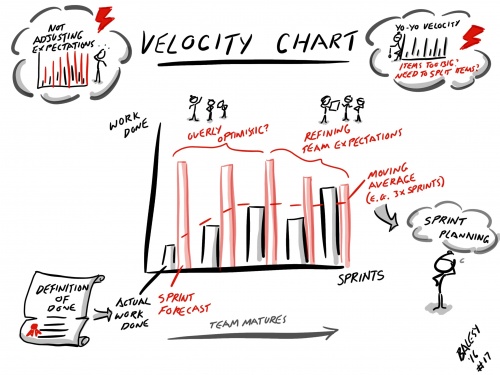Velocity Chart
The Velocity chart is another simple metric that determines how much work has been done per Sprint. If the amount of work is the distance travelled and the Sprint is the unit of time, then the velocity is the amount of work in a Sprint.
At the end of each Sprint, usually after the Sprint Review, the chart is updated to reflect how much work has been done with respect to the Definition of Done and accepted by the Product Owner.
How It Can Be Used
The velocity chart is a measure of a team’s capacity during a Sprint, how much work they can complete with regards the Definition of Done. This can then be used during Sprint Planning to influence how much work to bring into the Sprint, and when the team are over their exhibited capacity.
To help with this, it may also be a good idea to incorporate a moving average of say the last three Sprints to smooth out the variation from one Sprint to the next and provide a general trend rather than explicit values.
Who It Is For
The team ideally benefit from this metric as it informs them of their capacity during a Sprint, and so helps with future Sprint Planning.
How It Can Be Misused
Velocity charts show the capacity of a team in a Sprint. There will most likely be some variation from one Sprint to the next as some work is a little easier than anticipated and other work is more difficult, and so trying to get a perfect chart with exact amounts with no variation is unrealistic and contravenes the natural world.
Velocity charts are only for the team, however, if these are published to external parties and external stakeholders for example, then it is very likely that performance based discussions about the team’s throughput may take place, which can be distracting for the team and put them under unnecessary pressure to the detriment of their productivity.
Similarly, if quotas are placed upon team’s velocity as a target to meet in order to increase their performance, then this can also have a detrimental effect, as there is little respect for the team’s actual capacity and the recognition that all estimates are just guesses and that there will be variation in the system.
